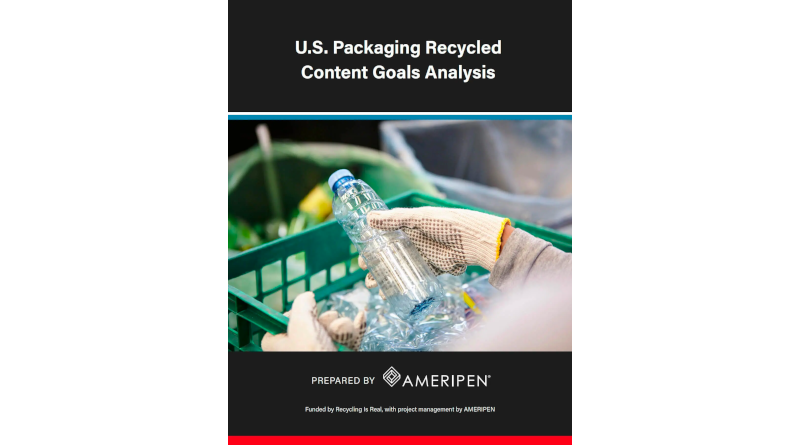New study reveals progress and challenges in meeting recycled content goals for packaging
A new report from AMERIPEN, prepared by Circular Matters and funded by PLASTICS’ Recycling is Real initiative, highlights significant progress by consumer-packaged goods (CPG) companies toward recycled content goals in packaging while also exploring critical gaps in infrastructure, collection systems, and supply to meet targets. Following last week’s member exclusive release webinar, U.S. Packaging Recycled Content Goals Analysis is now freely available for individuals and organisations to use in sustainability efforts.
Success in goals for post-consumer recycled (PCR) content will require coordination across this value chain; understanding where and why challenges may be occurring can provide further insight into effective interventions to ensure success. This new resource provides an update and expands on AMERIPEN’s 2021 report that explored the relationship between packaging recyclability and recycled content goals, domestic supply, and reprocessing capacity, and what, if any, additional policies or program supports could be supported to close potential gaps. A lot has happened in recycling and packaging since 2021, including new goals, new investment, and increased PCR usage – with this progress, AMERIPEN and Recycling Is Real felt quantifying impact again would provide value to many stakeholders.
“When we began our initial study over five years ago, we assumed that most goals would be developed for a broad portfolio of packaging formats and variety of materials and that we would be able to drill down into demand and supply curves for all those materials,” said Rob Keith, Membership & Policy Director at AMERIPEN. “To our surprise, outside of some plastics goals, we found most goals were framed in an either/or context (recyclable or sustainably sourced) or no recycled content objectives were publicly stated. This update to our 2021 study gives the packaging industry the ability to look more holistically at recycled content in packaging, leading to better sustainability outcomes.”
The updated U.S. Packaging Recycled Content Goals Analysis is the most comprehensive assessment to date of how voluntary corporate commitments, trade association targets, and state and federal laws align with the current and projected capacity of the U.S. recycling system. The study includes detailed data from 46 CPG companies, state legislation, and national trade associations covering paper, plastic, and aluminum packaging.
Key findings include:
• Progress being made: The average post-consumer recycled (PCR) content in plastic packaging more than doubled (from 5.3% in 2019 to 10.7% in 2023) among companies with stated goals.
• Supply gaps remain: Despite added reclamation capacity, the U.S. will still fall short in meeting 2025 plastics packaging goals, especially for PET, unless collection rates and advanced recycling capabilities increase significantly.
• State policies are gaining influence: Since 2020, at least 10 states have enacted laws mandating recycled content in packaging, adding new external pressures across the supply chain.
• Barriers persist which could benefit from intervention: Companies continue to cite limited availability of food-grade PCR, inconsistent material quality, and higher costs compared to virgin resins as primary obstacles.
• Increased Capacity: Between the 2021 and 2025 reports, U.S. plastics reclaimers have more than doubled their capacity to supply PCR to the packaging market.
“This study reflects encouraging momentum while also pointing to key opportunities for system-wide improvement,” said Patrick Krieger, Senior Vice President of Sustainability and Policy at PLASTICS. “With more companies committing to sustainable packaging and more states enacting mandates, we’re stepping up to meet demand. However, additional support—through stronger collection systems, clearer regulatory guidance, and greater investment in U.S. recycling infrastructure is essential to sustaining progress. Recycling is real and working—and our next challenge is aligning PCR goals with available supply and capacity.”
The report also cautions against policies that give preferential access to recycled materials, advocating instead for open, competitive markets that balance all end-uses of recovered materials.
As pressure mounts to increase the use of recycled content, it’s critical to understand how voluntary corporate goals and state legislation align with the realities of U.S. material supply and recycling infrastructure. When informed by objective current data, goals for recycled content in packaging will be more effective and achievable.

